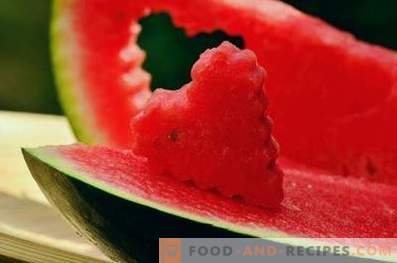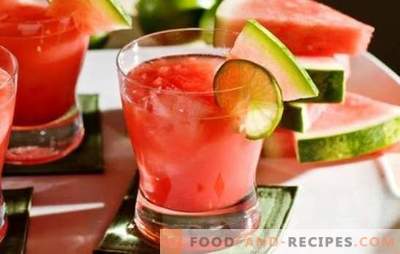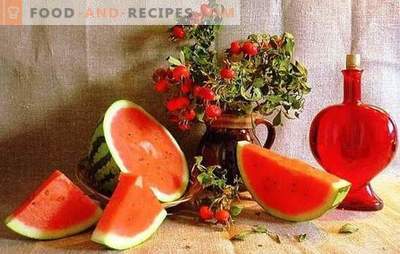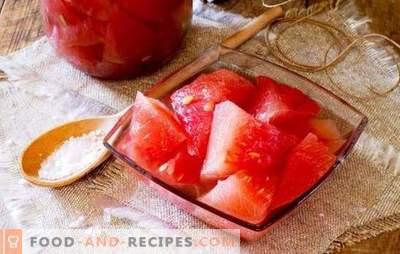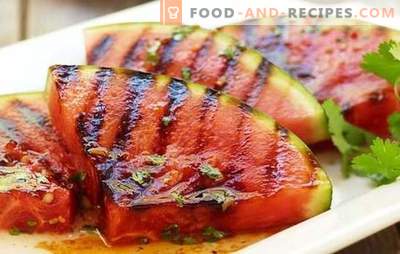
It is probably difficult to find a person in the open spaces of our country who would not like a watermelon. Juicy, sweet, healthy, it is a symbol of summer pleasure. In addition, watermelon is a real fount of folic acid, fiber, vitamin C, iron, and much more. Why, this berry is not at all simple - how many times has it happened that the whole family gathers around the table in anticipation of a long-awaited delicacy, and as a result gets a complete disappointment ...
Watermelon did not meet expectations, not at all sweet and not even red, or red, but completely tasteless ... money was wasted, children were disappointed, and adults could not get their little piece of childhood. Alas, the folk method of determining the maturity of a dry tail does not always work, and the knocking of a watermelon is most often completely useless, unless of course you know what sound a ripe fruit should make.
But that's not all. Recently, doctors are increasingly sounding the alarm - nitrates, which are stuffed with watermelons, lead to serious health problems. Nitrates are especially dangerous for the fragile children's organism, and watermelons want it so much ...
What to do to minimize the risk of poisoning and buy a really juicy and sweet watermelon? Turns out it's not at all difficult! Observing a few rules, you can almost certainly protect yourself from buying low-quality product.
Choose the time and place of purchase of watermelon
No matter how I would like to try a watermelon at the beginning of the summer, it is still worth refraining from buying. The real watermelon season begins not earlier than mid-August - until that time, not just a berry is offered on the shelves, but a real “nitrate cocktail”. Striped bun can look great, have a red juicy softness with ripe bones, but we assure you, this is all deception. In order to enjoy the watermelon without compromising health, one should carefully choose not only the time of purchase, but also the place. It is not naive to believe that the thick rind completely protects the berry from falling into it of roadside dust, since microorganisms calmly reach the pulp through microcracks. Usually 4 hours is enough for the fruit to absorb a large amount of heavy metals and become unsafe for health.
Therefore, leave the watermelons sold on the pistes and dumped in the roadside dust to the sellers, and go shopping for special trays equipped for selling melons, or to supermarkets. In large markets and in stores, as a rule, control is exercised over sellers and their goods.
Each product sold must have a certificate of conformity, and watermelons are also no exception. Do not be lazy or shy to be interested in this document, because we are talking not only about your health, but also about the health of your loved ones. The certificate will help to ensure the origin of the goods and the maximum talk about the indicators that affect the quality of watermelon.
The seller’s proposal to cut a triangle in a watermelon should be categorically rejected for a sample — thus, microbes that reproduce fruitfully on a knife blade for a long time and fruitfully get inside the fruit. It is better to read and remember a few simple rules that will help not to be mistaken with the choice.
How to choose a ripe and sweet watermelon
- The first rule is that we absolutely do not buy watermelons with defects, cracks and cuts! Even despite the discounts and assurances of sellers that there is nothing to worry about. The sale of cut watermelons is prohibited by law. When buying fruits with a defect, the risk of poisoning increases by several times.
- Size matters - the larger the watermelon, the greater the likelihood that it is ripe. But too much watermelon should not be chosen either - most likely, it was artificially fed. Ideal weight - 7-10 kg.
- Pay attention to the appearance of the fetus and its weight. If a big watermelon turns out to be easy - this is our client, you should look to him more carefully. And if the watermelon rind has a pronounced contrasting color, you can think seriously about buying. It has long been observed that watermelons with a dull matte skin usually lose in taste to their bright counterparts.
- Next step - carefully inspect the stem. If it is missing, the watermelon should not even be considered - most likely, the tail was deliberately pulled off to hide the poor quality of the fruit. The peduncle should be yellowish and moderately dry - the over-dried tail says that the watermelon was transported and stored for a long time, which hardly had a positive effect on its taste.
- The yellow spot on the peel of the watermelon is the place that lay on the ground. In young and immature fruits, the spot is most often white, and in ripe fruit it is yellow or orange. So, we stop our choice on a watermelon with a large yellow “cheek”.
- Now we take the “patient” in our hands - to determine the degree of maturity from the sound. Bring the fruit to your ear and squeeze with your hands - you should get the feeling that the watermelon is about to crack from maturity. The skin of a watermelon, when squeezed, usually bends slightly and cracks. Unripe watermelon usually remains silent. When tapping, a ringing sound should be heard, as if the fruit wants to split.
- Boy or girl? As a rule, everyone prefers to buy “watermelon” and rightly so. In the "girls" are much smaller seeds, and the fruits themselves more juicy and sweet. In male watermelons, the side opposite to the tail is convex, and the female fruit side is flat and has a wide circle.
Last tip - do not get fooled by the sellers' sweet speeches, believe your eyes and sensations. Do not hesitate and do not be lazy to put your knowledge into practice. All the above recommendations should be applied together, not separately.
Choosing a watermelon without nitrates
In pursuit of profit, unscrupulous sellers overfeed watermelons with nitrogen fertilizers, which get into the fruit, and then into the human body. Unfortunately, no one knows how to choose a watermelon without nitrates, guaranteed. Visually determine the "chemical past" of watermelon is also impossible. The only guarantee is to grow the fruit yourself or personally know the seller.
You can, of course, walk around the market with a nitratomer, but it is unlikely that everyone has such a device. Therefore, before you treat children and other family members with a purchased watermelon, you should carefully look at the sliced fruit. The following signs should alert:
- If there is a large number of thick yellowish streaks in the pulp of the fruit, then the amount of nitrates in such fruit is greatly exceeded. Normal fibers should be white.
- If the pulp of the watermelon is red and the seeds are white, the watermelon is overfed with nitrates.
- Another sign of the presence of nitrates is a smooth and glossy cut surface. Normally, the cut should sparkle with grains.
- You can take a small piece of the pulp of the fruit and stir it in a glass with water - if the water is cloudy, the watermelon is safe, and if the water is painted in a bright pink color, the fruit is overnourished with nitrates.
Nitrates in watermelon are unevenly distributed - the largest concentration falls on the area closer to the crust. Therefore, if there is any doubt, do not nibble the watermelon to the skin, and it’s generally better for children to give only the middle one - it is sweeter and safer.
That's actually all the simple rules for choosing a watermelon. Before use, do not forget to thoroughly wash the watermelon under running water, and you can store the cut fruit in the refrigerator for up to three days. Enjoy your meal!
